Cite this document
(“Discretion Granted to National Courts in Relation to the EU Legal Essay”, n.d.)
Discretion Granted to National Courts in Relation to the EU Legal Essay. Retrieved from https://studentshare.org/law/1447668-the-discretion-granted-to-national-courts-in-the
Discretion Granted to National Courts in Relation to the EU Legal Essay. Retrieved from https://studentshare.org/law/1447668-the-discretion-granted-to-national-courts-in-the
(Discretion Granted to National Courts in Relation to the EU Legal Essay)
Discretion Granted to National Courts in Relation to the EU Legal Essay. https://studentshare.org/law/1447668-the-discretion-granted-to-national-courts-in-the.
Discretion Granted to National Courts in Relation to the EU Legal Essay. https://studentshare.org/law/1447668-the-discretion-granted-to-national-courts-in-the.
“Discretion Granted to National Courts in Relation to the EU Legal Essay”, n.d. https://studentshare.org/law/1447668-the-discretion-granted-to-national-courts-in-the.


